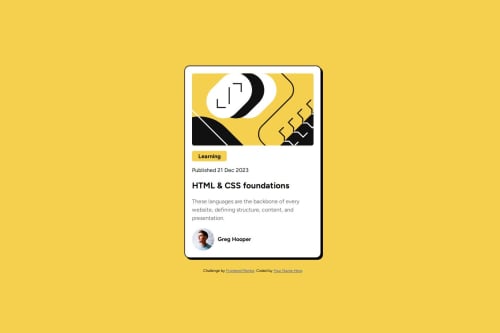
Solution retrospective
pretty straight forward. looking to make sure my css isnt over engineered
What challenges did you encounter, and how did you overcome them?keep code to a minimum so its easier to read
What specific areas of your project would you like help with?same as above. would like feedback on css mainly
Please log in to post a comment
Log in with GitHubCommunity feedback
- @OscarE2D
✅ Positive Aspects
-
Semantic HTML Structure: Your use of semantic HTML elements enhances accessibility and provides a clear structure to the content.
-
Responsive Design: Implementing a responsive layout ensures that the blog preview card adapts well to various screen sizes, improving the user experience across devices.
-
Interactive Elements: Incorporating pseudo-classes like
:hoverand:focusadds interactivity, making the UI more engaging. -
Use of Modern CSS Techniques: Utilizing Flexbox and CSS Grid demonstrates a good grasp of modern layout methods, allowing for flexible and efficient design implementations.
🛠 Suggestions for Improvement
-
README Enhancement: Consider expanding your README to include sections like "What I Learned" and "Continued Development." This not only showcases your learning journey but also provides context for others reviewing your code.
-
Code Organization: Organizing your CSS using methodologies like BEM (Block Element Modifier) or adopting a modular structure can improve maintainability and scalability.
-
Accessibility Considerations: Ensuring that interactive elements are accessible via keyboard navigation and providing appropriate ARIA labels can enhance the inclusivity of your project.
-
Consistent Styling: Maintaining consistent spacing, font sizes, and color schemes throughout the project can lead to a more cohesive and professional appearance.
-
Join our Discord community
Join thousands of Frontend Mentor community members taking the challenges, sharing resources, helping each other, and chatting about all things front-end!
Join our Discord